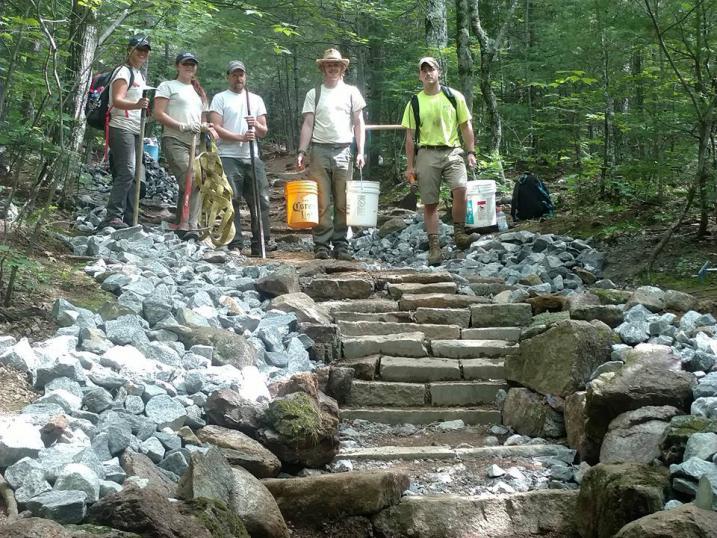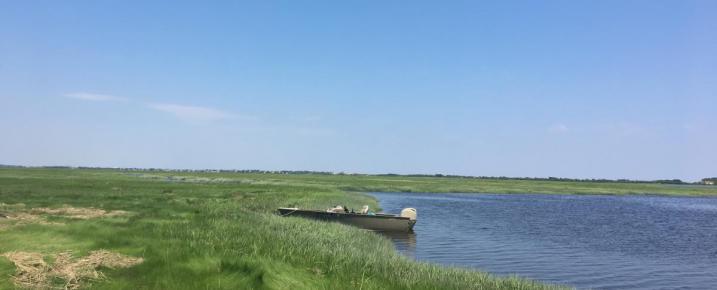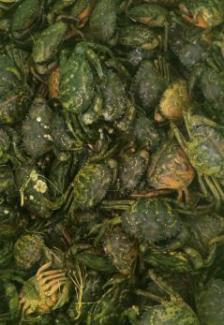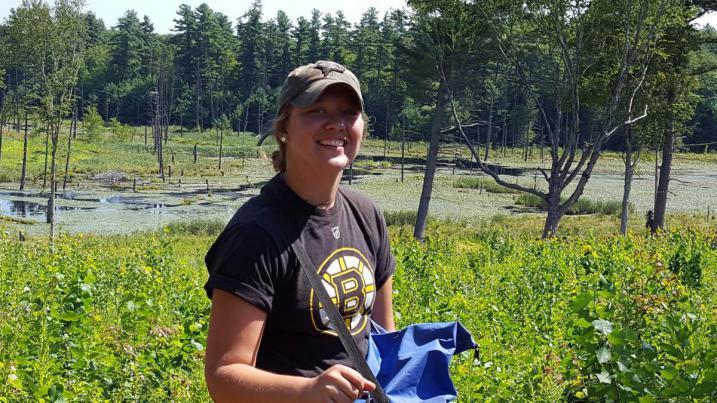Here, There, and Everywhere

It has been over a month since my last article, but a whole lot has happened! I had another fantastic two weeks back at Parker River National Wildlife Refuge with the U.S. Fish and Wildlife Service! The pepperweed was in full bloom when I got back, so the majority of our effort was dedicated to pulling as much as we could before it started to seed. As I mentioned in my first story, perennial pepperweed is widespread, fast growing invasive plant that thrives in and near salt marshes and on the edges of roads. Pulling stops once it starts to seed, to avoid additional spreading of the seeds that would allow it to further establish itself. We spent a few days on the boat, hopping on and off, pulling the plants in the marsh that we were unable to reach by foot.

I also had the opportunity to spend the day at New Hampshire Fish and Game’s karner blue butterfly breeding lab in Concord. The karner blue butterfly is both state listed and federally listed as “Endangered.” Karner blue caterpillars only feed on the leaves of lupine plants, making them very vulnerable to habitat loss. There is only one wild population of karner blues in New Hampshire, in the Concord Pine Barrens. In the lab, the butterflies are bred and the offspring are raised until adulthood, when they are released to the pine barrens. We began by planting lupine plants and nectar plants (i.e. New Jersey tea) on a piece of land near the lab. Then we spent the afternoon collecting lupine seeds from their pods, and setting up new mating tents for the butterflies.


After I left USFWS, I spent two weeks working with Steve Eisenhaure and his crew at the UNH Office of Woodlands and Natural Areas. Steve is the Land Use Coordinator for all of the UNH properties, working out of the office at Kingman Farm in Madbury, NH. Throughout my two weeks working with the crew, we started by doing trail maintenance work, in conjunction with the Squam Lakes Association on West Rattlesnake Mountain, in Holderness, NH. We built granite steps in a section of the trail that had been washed out in the spring. We hauled granite blocks up the mountain to the site that needed fixing. At the trailhead, there was a pile of stones and a pile of gravel that had been donated by RS Eastman Property Maintenance. Hikers using the trail helped us out by hauling buckets of rocks or gravel up to our work site! During our time at Squam, we also cleared out the water bars that were already in place, in hopes of preventing another washout by diverting the water away from the trail.

When we weren’t in Holderness, we spent time weed-whacking and clearing brush from other UNH properties.We met one morning with Bill Day, of Oak Country Lumber, at his log yard in Chichester, NH, to learn about his job and the grading system that is used for logs. We also spent a few days at the Lord property in Ossipee, NH, marking trees for an upcoming timber harvest. This involves planning out skid trails that the logging equipment will be able to get to, and then determining which trees should be harvested, and which should be allowed to continue to grow, taking competing trees, health of the tree, and wildlife use into consideration. The trees that will be harvested are identified, their diameter is measured, and they are marked with tree marking paint, so that the equipment operator will know which trees to take.

After an awesome two weeks with Steve and his crew, I headed back to Parker River National Wildlife Refuge for one last week with the U.S. Fish and Wildlife Service! We spent one morning helping out with a green crab count with some community members in Newbury, MA. The European green crab is an invasive species that feeds on native soft-shelled clams and blue mussels, depleting native shellfish resources. We first emptied the crab traps into bags, and took each crab out, one by one, determined its sex, and measured its carapace, recording the information. During my last week with USFWS, I spent a few days, with the other interns, doing a Beach Discovery Program on the refuge beach. The Beach Discovery Program consists of a table on the beach with microscopes so you can compare sand grain sizes from different areas of the refuge, information on shorebird identification, and information on the best ways to reduce your impact on the beach. This is a great way to educate and get people excited about the science of the beach!
On one of my last days with the USFWS team, we took a trip to the Wapack National Wildlife Refuge, near Peterborough, NH, which is also managed by the administration of Parker River NWR. We spent the day hiking and admiring the views!

My final week was working with Phil Auger, the Land Manager of the Southeast Land Trust of New Hampshire. SELT conserves land in Rockingham and Strafford Counties for a variety of purposes, including agriculture, outdoor recreation, and habitat for wildlife. My first day with Phil, we met with Charlie Moreno, a local forester, and Ellen Snyder, a habitat biologist, to walk a property that SELT recently acquired, to talk about how the land would be best managed.

My second day with SELT, we had a volunteer day with the employees of a company called Vapotherm. We worked on an accessible trail at Mast Road Natural Area in Epping. I worked with three longtime “SELTies”, Walt, Peter, and Steve, laughing and building bog bridges for the areas on the trail that hold water, and making the existing bridges more wheelchair accessible. Phil and the Vapotherm volunteers worked on moving gravel and dirt, raising up and packing down the trail. Another day we spent seeding trails on two different properties, with grasses and clover for use by wildlife and to prevent erosion that could occur if the trail were Through the rest of my week with Phil, we walked many properties, checking and flagging boundary lines and measuring for fence posts. Phil always made sure to give me a full history of each property that we visited and never failed to point out wildlife, even when we were driving down the road!
My last day ended on a high note, at a “Tool Party,” painting and labeling tools, then arranging them in the brand new tool room that the Stewardship Network: New England has in the barn at Burley Farm, one of the beautiful SELT properties!